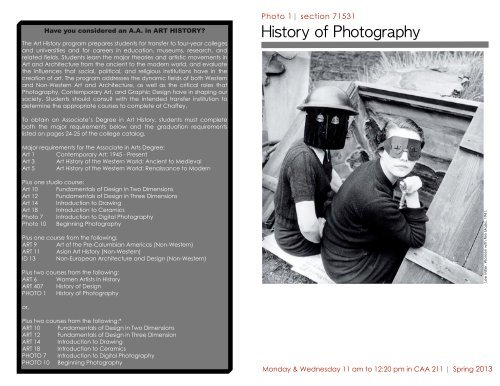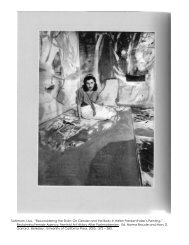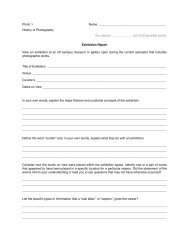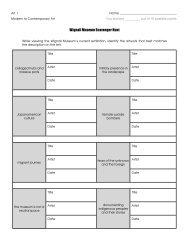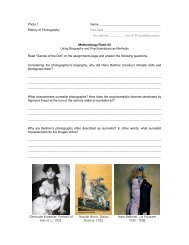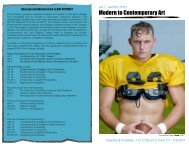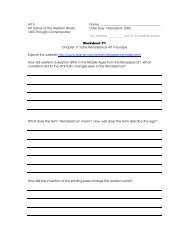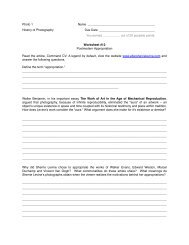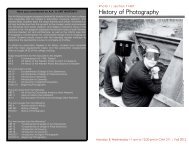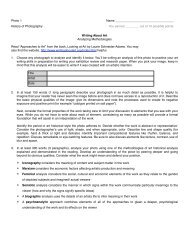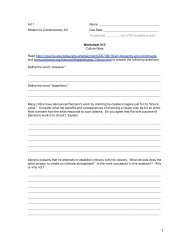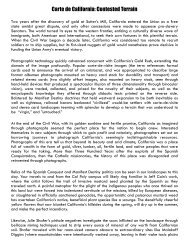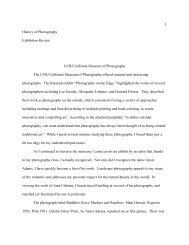a printable syllabus - the Slide Projector!
a printable syllabus - the Slide Projector!
a printable syllabus - the Slide Projector!
Create successful ePaper yourself
Turn your PDF publications into a flip-book with our unique Google optimized e-Paper software.
Have you considered an A.A. in ART HISTORY?<br />
The Art History program prepares students for transfer to four-year colleges<br />
and universities and for careers in education, museums, research, and<br />
related fields. Students learn <strong>the</strong> major <strong>the</strong>ories and artistic movements in<br />
Art and Architecture from <strong>the</strong> ancient to <strong>the</strong> modern world, and evaluate<br />
<strong>the</strong> influences that social, political, and religious institutions have in <strong>the</strong><br />
creation of art. The program addresses <strong>the</strong> dynamic fields of both Western<br />
and Non-Western Art and Architecture, as well as <strong>the</strong> critical roles that<br />
Photography, Contemporary Art, and Graphic Design have in shaping our<br />
society. Students should consult with <strong>the</strong> intended transfer institution to<br />
determine <strong>the</strong> appropriate courses to complete at Chaffey.<br />
Photo 1| section 71531<br />
History of Photography<br />
To obtain an Associate’s Degree in Art History, students must complete<br />
both <strong>the</strong> major requirements below and <strong>the</strong> graduation requirements<br />
listed on pages 24-25 of <strong>the</strong> college catalog.<br />
Major requirements for <strong>the</strong> Associate in Arts Degree:<br />
Art 1 Contemporary Art: 1945 - Present<br />
Art 3 Art History of <strong>the</strong> Western World: Ancient to Medieval<br />
Art 5 Art History of <strong>the</strong> Western World: Renaissance to Modern<br />
Plus one studio course:<br />
Art 10 Fundamentals of Design in Two Dimensions<br />
Art 12 Fundamentals of Design in Three Dimensions<br />
Art 14 Introduction to Drawing<br />
Art 18 Introduction to Ceramics<br />
Photo 7 Introduction to Digital Photography<br />
Photo 10 Beginning Photography<br />
Plus one course from <strong>the</strong> following:<br />
ART 9 Art of <strong>the</strong> Pre-Columbian Americas (Non-Western)<br />
ART 11 Asian Art History (Non-Western)<br />
ID 13 Non-European Architecture and Design (Non-Western)<br />
Plus two courses from <strong>the</strong> following:<br />
ART 6 Women Artists in History<br />
ART 407 History of Design<br />
PHOTO 1 History of Photography<br />
Lee Miller. Women with Fire Masks. 1941.<br />
or,<br />
Plus two courses from <strong>the</strong> following:*<br />
ART 10 Fundamentals of Design in Two Dimensions<br />
ART 12 Fundamentals of Design in Three Dimension<br />
ART 14 Introduction to Drawing<br />
ART 18 Introduction to Ceramics<br />
PHOTO 7 Introduction to Digital Photography<br />
PHOTO 10 Beginning Photography<br />
Monday & Wednesday 11 am to 12:20 pm in CAA 211 | Spring 2013
Grade Table<br />
Instructor:<br />
Denise Johnson<br />
Keep a record of <strong>the</strong> points you have earned this semester on this table.<br />
Compute your grade percentage by dividing <strong>the</strong> number of points you<br />
have earned by <strong>the</strong> number of points possible at <strong>the</strong> time (points earned<br />
÷ points possible = %). Look your percentage up on page 3 of this <strong>syllabus</strong><br />
to find your grade. Bring this table, with earned points recorded, to any<br />
meetings with <strong>the</strong> instructor considering your grade!<br />
Office hours: Happy to meet with you by<br />
appointment in CAA 302<br />
Mailbox: CAA 302<br />
Email: denise.johnson@chaffey.edu<br />
Voice mail: 909.652.7867<br />
Earned<br />
Points Possible<br />
Methodology Flash Brainstorm 1 out of 10 points<br />
Quizzes<br />
(subtract lowest<br />
score)<br />
Learning<br />
Analysis 1<br />
Brainstorm 2<br />
Analysis 2<br />
Brainstorm 3<br />
Analysis 3<br />
Brainstorm 4<br />
Analysis 4<br />
Brainstorm 5<br />
out of 28 points<br />
out of 10 points<br />
out of 28 points<br />
out of 10 points<br />
out of 28 points<br />
out of 10 points<br />
out of 28 points<br />
out of 10 points<br />
Analysis 5 out of 28 points 180 points<br />
Quiz #1<br />
Quiz #2<br />
Quiz #3<br />
Quiz #4<br />
out of 30 points<br />
out of 30 points<br />
out of 30 points<br />
out of 30 points<br />
Final Quiz out of 35 points 125 points<br />
Community #1<br />
out of 15 points<br />
Communities Community #2 out of 15 points<br />
Community #3<br />
Community #4<br />
out of 15 points<br />
out of 15 points<br />
Community #5 out of 15 points 75 points<br />
Projects<br />
Project 1 out of 20 points<br />
Project 2<br />
out of 20 points<br />
Project 3 out of 20 points 60 points<br />
Activity Reports Scavenger Hunt out of 10 points<br />
Extra Credit<br />
Exhibition<br />
out of 25 points<br />
Event out of 25 points 60 points<br />
Sub-Total<br />
Total<br />
max 25 points<br />
out of 500 points<br />
12
Resources<br />
Table of Contents<br />
Student Success Centers<br />
Chaffey College has created a network of Student Success Centers<br />
which offer free tutorials, workshops, learning groups, directed learning<br />
activities, and computer/resources access--to assist students in <strong>the</strong>ir<br />
academic development and success.<br />
The Rancho Multidisciplinary Center is located in <strong>the</strong> Library and is open<br />
Monday - Thursday 8 am to 8 pm, and Friday 10 am to 2 pm.<br />
A current Chaffey College photo ID card is required for all Success Center<br />
services. Walk-ins are welcome, and advanced appointments are<br />
available for most services. Call <strong>the</strong> Centers or consult <strong>the</strong> college website<br />
at www.chaffey.edu/success/ for more information.<br />
Disability Programs & Services<br />
Chaffey’s Disabled Students Programs and Services, or DPS, serves an<br />
estimated 1500 students across all Chaffey campuses. DPS serves students<br />
with physical, learning, and psychological/psychiatric disabilities by<br />
providing accommodations based on <strong>the</strong> type of disability and verifying<br />
documentation. Services include academic counseling, disability related<br />
counseling and referral for community resources, test accommodations,<br />
tram services, adapted computer lab, assistive technology training,<br />
assessment, and equipment loan. For more information contact <strong>the</strong> DPS<br />
general phone line at (909) 652-6379.<br />
Veterans Resource Center<br />
The Veterans Resource Center (VRC) is dedicated to assisting veterans<br />
and eligible family members in achieving <strong>the</strong>ir educational goals<br />
efficiently and without impediments. If you are a veteran or eligible family<br />
member, please contact <strong>the</strong> Veterans Resource Center at (909) 652-6235<br />
or vrc.staff@chaffey.edu for information regarding educational benefits<br />
and opportunities. The Veterans Resource Center (VRC) is located in<br />
building AD-125 on <strong>the</strong> Rancho campus.<br />
Career Center<br />
The Career Center helps Chaffey College students find meaningful<br />
careers. The program offers career counseling, career assessments,<br />
résumé assistance, interviewing skills preparation, job referrals, student<br />
employment, and career related workshops. The Career Center is located<br />
in MACC 203. Please call (909) 652-6511 for more information.<br />
About this Course...............................................................................page 1<br />
Student Learning Outcomes<br />
Materials................................................................................................page 2<br />
Required Text<br />
Recommended Texts<br />
Instructional Websites<br />
Important Dates..................................................................................page 3<br />
Grades....................................................................................................page 3<br />
Coursework Percentages<br />
Point Breakdown<br />
Study Time<br />
Class Schedule....................................................................................page 4<br />
Coursework...........................................................................................page 8<br />
Policies...................................................................................................page 9<br />
Attendance<br />
Texting<br />
Respect is Key!<br />
Cheating and Plagiarism<br />
Late Assignments<br />
Online Quizzes<br />
Extra Credit<br />
Resources............................................................................................page 11<br />
Student Success Centers<br />
Disability Programs and Services<br />
Veterans Resource Center<br />
Career Center<br />
Grade Table.........................................................................................page 12<br />
An A.A. in Art History?...............................................................back cover<br />
11
History of Photography<br />
This course will explore <strong>the</strong> history of photography from its foundations in<br />
<strong>the</strong> Renaissance to its incredible influence on art <strong>the</strong>ory in <strong>the</strong> 21 st<br />
century. Visual language and art terminology will be used to examine<br />
photographs from a wide assortment of historical, social, political and<br />
personal contexts. During this investigation, students will be encouraged<br />
to develop and maintain a critical eye that takes nothing for granted<br />
and is actively engaged in questioning. Through this critical examination,<br />
students will gain a general level of knowledge, understanding and<br />
appreciation for <strong>the</strong> artistic practice of photography and its history.<br />
Student Learning Outcomes<br />
Upon successful completion of this course:<br />
• Students will professionally critique fashion and<br />
advertising imagery.<br />
• Students will demonstrate a critical understanding of<br />
cultural and social diversity through written and oral<br />
discussions that compare and contrast imagery from<br />
from around <strong>the</strong> world.<br />
Late Assignments<br />
You may turn one assignment in one class day late. The late assignment<br />
will not be marked down, however any assignments turned in more than<br />
one class late, or in addition to <strong>the</strong> one accepted assignment, will NOT<br />
receive credit.<br />
Complete Assignments Before Class Begins<br />
Assignments need to be turned in at <strong>the</strong> start of class. Please do not<br />
complete course work in class.<br />
Online Quizzes<br />
Quizzes will be taken online on <strong>the</strong> course’s Moodle page. In progress<br />
quizzes can be saved, printed, and updated. However, once <strong>the</strong> quiz<br />
has been submitted, answers cannot be edited. Make-up quizzes<br />
cannot be accommodated, except under extenuating circumstances!<br />
Extra Credit<br />
Opportunities to earn extra credit may be announced during class.<br />
However, students are limited to earning a maximum of 25 extra credit<br />
points (five percent) during <strong>the</strong> semester. Any points earned above 5%<br />
of <strong>the</strong> total course grade will NOT be applied to <strong>the</strong> final grade.<br />
• Students will engage in original thinking through oral<br />
discussion and written synopsis of <strong>the</strong>ir own beliefs<br />
regarding <strong>the</strong> role of photojournalistic reportage and<br />
ethical responsibilities in politically charged situations.<br />
1 10
Policies<br />
Materials<br />
9<br />
To ensure that our learning community functions well and that everyone<br />
is treated with <strong>the</strong> respect that <strong>the</strong>y deserve, we must all agree to <strong>the</strong><br />
following courtesies and guidelines.<br />
Attendance<br />
Good attendance is essential to your success! While you will not be<br />
graded on your attendance, numerous absences are sure to<br />
negatively effect your grade.<br />
Take a Break from Texting!<br />
Please DO NOT text message during class. If you need to attend to<br />
an important message, please leave <strong>the</strong> classroom and return when<br />
you can fully commit your attention to <strong>the</strong> class discussion.<br />
Respect is Key<br />
We will often consider provocative and challenging subject matter in<br />
this class and must <strong>the</strong>refore agree to respect each o<strong>the</strong>r’s views and<br />
identities. Our diverse backgrounds and opinions are assets and no<br />
student shall be made to feel inferior or uncomfortable because of<br />
<strong>the</strong>ir race, ethnicity, gender, sexual orientation, religious beliefs or<br />
physical/ intellectual abilities.<br />
Cheating and Plagiarism Policy<br />
Integrity is an essential component of <strong>the</strong> student academic<br />
experience. The academic evaluation a student receives for a<br />
course becomes a permanent college record and it is critical that<br />
such records be accurate and consistent. The integrity students learn<br />
and exhibit at <strong>the</strong> college will be a model for <strong>the</strong> professional integrity<br />
<strong>the</strong>y practice when <strong>the</strong>y<br />
complete <strong>the</strong>ir college<br />
work. Accordingly, Chaffey<br />
College has classified<br />
academic dishonesty into<br />
<strong>the</strong> following categories<br />
and included examples for<br />
each category: cheating,<br />
unauthorized collaboration,<br />
f a c i l i t a t i n g a c a d e m i c<br />
dishonesty, interference or<br />
sabotage, plagiarism,<br />
fabrication and retaliation.<br />
Thomas Struth. Kunsthistorisches Museum III Wien. 1989.<br />
Required Text<br />
★ Marien, Mary Warner. Photography: A Cultural History. Any edition.<br />
Upper Saddle River, NJ: Prentice Hall, 2006.<br />
(On reserve at <strong>the</strong> Chaffey College Library RES 770 JOH1)<br />
Recommended Texts<br />
College Dictionary and Thesaurus<br />
★<br />
★<br />
D’Alleva, Anne. Methods & Theories of Art History. Second ed.<br />
London: Laurence King Publishing, 2012.<br />
Gibaldi, Joseph. MLA Handbook for Writers of Research Papers.<br />
Seventh ed. New York: Modern Language Association of America,<br />
2009. (Chaffey Library 808.02 G43)<br />
These titles may be rented from <strong>the</strong> Chaffey bookstore.<br />
Instructional Websites<br />
This course will be taught from an instructional website called “The <strong>Slide</strong><br />
<strong>Projector</strong>,” www.<strong>the</strong>slideprojector.com. Lecture presentations,<br />
assignments, and course materials will be available at this site, and you<br />
will need to access it regularly.<br />
Quizzes will be taken on <strong>the</strong> class Moodle site at moodle2.chaffey.edu/.<br />
The college’s library offers FREE<br />
internet access for current students<br />
with a Chaffey ID.<br />
2
Important Dates<br />
Coursework<br />
Add Deadline<br />
The deadline to add this course with an add code is January 22.<br />
Drop Deadline<br />
Students wishing to drop <strong>the</strong> course, must do so via MyChaffey View by<br />
January 29 without record, or by April 10 with a “W” grade.<br />
Submission Deadline<br />
All coursework must be submitted by <strong>the</strong> last day of lecture. NO COURSE<br />
WORK WILL BE ACCEPTED AFTER 12:20 PM ON May 15!!<br />
Grades<br />
Grades will be available online by June 3.<br />
Grades<br />
There are 500 points possible in this class. Thirty-Eight percent of your grade<br />
will be earned through Methodology Flash assignments, 25% by taking<br />
online quizzes, 15% by writing quiz questions with your Learning<br />
Community, 12% by submitting three hands-on projects, and 12% by<br />
completing three Activity Reports.<br />
A 100% - 90% 500 – 448 points<br />
B 89% - 80% 447 – 398 points<br />
C 79% - 70% 397 – 348 points<br />
D 69% - 60% 347 – 297 points<br />
F 59% or less 296 – 0 points<br />
Students are strongly encouraged to keep track of earned points on <strong>the</strong><br />
Grade Table included in this <strong>syllabus</strong>. If requesting an appointment to<br />
review your grade, you will be asked to bring <strong>the</strong> table with you!<br />
Study Time<br />
Students should plan on spending two to three hours reading, fulfilling<br />
assignments, writing <strong>the</strong> research paper and studying for every hour spent<br />
in <strong>the</strong> classroom. That’s 96 - 144 hours of Photo 1 study time you should<br />
allow for this semester!<br />
Methodology Flash - 5 X 38 = 190 points<br />
This semester, you will learn how to analyze photographs using a variety of<br />
art historical methodologies. These methods will be demonstrated in class,<br />
and throughout required readings. To reinforce your understanding, and<br />
to provide students an opportunity to demonstrate <strong>the</strong>ir analytic skills using<br />
<strong>the</strong>se methodologies, you will meet with your Learning Community<br />
(explained below) six times during <strong>the</strong> semester to write an analysis of a<br />
photograph provided by a student in Julie Shafer’s Photo 7 Digital<br />
Photography class. These analyses will be uploaded to moodle, <strong>the</strong>n<br />
posted to The <strong>Slide</strong> <strong>Projector</strong> along with <strong>the</strong> Photo 7 work. They will<br />
demonstrate a practical understanding of <strong>the</strong> methodologies, and <strong>the</strong>ir<br />
use, as well as MLA citation style. Each Flash will be worth 38 points total.<br />
Learning Communities - 5 X 15 = 75 points<br />
Students will be randomly organized into Learning Communities that will<br />
work on Methodology Flashes toge<strong>the</strong>r, and periodically write ten<br />
relevant questions (with answers) that will be reviewed by <strong>the</strong> instructor to<br />
assess comprehension and depth of understanding. Well written and<br />
critically engaging questions will be used on <strong>the</strong> next quiz. Communities<br />
will submit ten questions worth fifteen points, during five meetings.<br />
Quizzes - (4 X 30 - lowest score) + 35 points = 125 points<br />
Students will submit four 30 point quizzes taken on Moodle. Quiz questions<br />
will derive from Learning Community meetings and will be made available<br />
on Thursdays. Quizzes must be submitted by 11:59 pm on <strong>the</strong>ir due date.<br />
The lowest quiz score will be dropped.<br />
A mandatory, comprehensive final quiz, that will be taken in advance of<br />
final grade appointments, will be worth 35 points.<br />
Projects 3 X 20 = 60 points<br />
Students will submit three projects chosen from a variety of hands-on<br />
activities provided throughout <strong>the</strong> semester, worth up to 20 points each.<br />
Activity Reports - 10 + 25 + 25 points = 60 points<br />
Students will be asked to submit three activity reports aiming to connect<br />
course content within <strong>the</strong> art community at large. The 10 point Wignall<br />
Museum Scavenger Hunt will introduce students to <strong>the</strong> Rancho campus’s<br />
contemporary art venue and its valuable instructional offerings. An<br />
Exhibition Report, worth 25 points, will require students to view in person an<br />
exhibition held at an off-campus art venue this semester. An Event Report,<br />
worth 25 points, will require students to attend an on-campus event.<br />
3 8
Class Schedule and Required Reading - This is a tentative schedule that may be changed during <strong>the</strong> semester.<br />
Date Discussion Topic & Reading Assignment Due<br />
January 14 Introduction<br />
January 16 Before Photography<br />
Introduction – page 7<br />
Student Information Sheet<br />
January 21 Martin Lu<strong>the</strong>r King Jr. Holiday - No Class<br />
Martin Lu<strong>the</strong>r King Jr. Holiday - No Class<br />
January 23 Invention of Photographies<br />
Pages 7 – 12<br />
Approaches to Art<br />
In-Class Brainstorm<br />
January 28 The Daguerreotype<br />
Pages 12 – 17 & 58 – 73<br />
Methodology Flash 1<br />
January 30 The Expanding Domain<br />
Pages 17 – 31<br />
February 4 Photography’s Re-Invention<br />
Pages 74 – 75<br />
February 6 Encyclopedic Knowledge<br />
Pages 32 – 42, & 46 – 58<br />
Learning Community 1<br />
February 11 Picturing Science<br />
Chapter 5<br />
Quiz 1<br />
February 13 Photography in Conflict<br />
Pages 43 – 45 & 99 -126<br />
In-Class Brainstorm<br />
February 18 Washington Holiday - No Class<br />
Washington Holiday - No Class<br />
February 20 Imagining <strong>the</strong> West<br />
Pages 127 - 142<br />
Methodology Flash 2<br />
February 25 Studies in Motion<br />
Pages 210 – 216<br />
Project 1<br />
February 27 Amateur Practices<br />
Pages 84 – 98<br />
Learning Community 2<br />
March 4 The Impact of <strong>the</strong> Hand-Held<br />
Pages 162 – 169, & 195 – 210<br />
Quiz 2<br />
March 6 Pictorialism<br />
Pages 170 – 194<br />
In-Class Brainstorm<br />
March 11 The Modern Avant-Garde Methodology Flash 3<br />
March 13 Straight Photography<br />
Pages 230 - 233<br />
Wignall Scavenger Hunt
Date Discussion Topic Assignment Due<br />
March 18<br />
March 20<br />
Spring Break - No Class<br />
March 25 New Vision<br />
Pages 234 - 242 & 262 - 263<br />
March 27 Healing <strong>the</strong> Madness<br />
Pages 242 - 259<br />
Learning Community 3<br />
April 1 Social Documentary<br />
Pages 278 - 285<br />
Quiz 3<br />
April 3 Group f/64<br />
Pages 268 – 277<br />
In-Class Brainstorm<br />
April 8 The Golden Age of News Photography<br />
Pages 286 – 309<br />
Methodology Flash 4<br />
April 10 Decisive Moment<br />
April 15 The Atomic Age<br />
Pages 299 - 308<br />
Project 2<br />
April 17 The Family of Man?<br />
Chapter 10<br />
April 22 The Americans<br />
Pages 338 – 349<br />
Event Report<br />
April 24 Social Landscape<br />
Pages 349 – 354<br />
Learning Community 4<br />
April 29 Through <strong>the</strong> Lens of Culture<br />
Pages 354 – 371<br />
Quiz 4<br />
May 1 Postmodernism<br />
Pages 372 - 404<br />
In-Class Brainstorm<br />
May 6 Appropriation<br />
Pages 437 - 453<br />
Methodology Flash 5<br />
May 8 Photographic Politics<br />
Pages 454 & 474 - 489<br />
Exhibition Report<br />
May 13 The Death of Photography?<br />
Pages 405 - 436 & 490 - 491<br />
Project 3<br />
May 15 Through <strong>the</strong> Camera<br />
Chapter 14<br />
Learning Community 5<br />
May 19 Final Quiz Final Quiz<br />
May 21 Grade Appointments 11:30 am - 2 pm<br />
Grade Appointments 11:30 am - 2 pm


